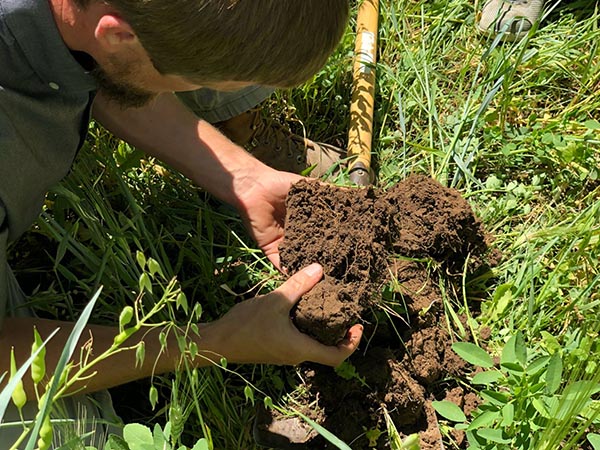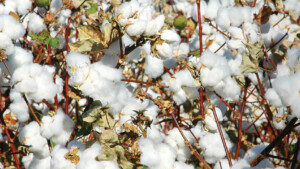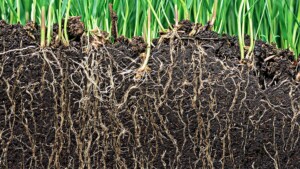What are Humates?
Think of them as nature’s ancient compost; the carbon-rich remains of prehistoric plants. Humates are organic compounds formed from decomposed plant matter. Humic substances are a complex blend of humic and fulvic acids, along with humin, extracted from lignites, leonardites and peats.

How do Humates help crops?
Humates are nature’s most powerful biostimulants. They stimulate plant photosynthesis, nutrient uptake and absorption, and antioxidant production to combat environmental stress. By stimulating fine root production and increasing root exudates, humates improve soil organic matter and boost populations of microbes to enhance crop growth.

You Asked, We Answered.

Why Should You Apply Humates?
- HIGHER YIELDS: Humates lead to higher crop yields and better-quality produce.
- BETTER SOIL HEALTH: Humic substances help create healthier, more fertile soil with a balanced pH, supporting robust plant growth.
- REDUCED CHEMICAL INPUTS: With improved soil health, the need for synthetic fertilizers is reduced, promoting more profitable, eco-friendly farming practices.
We Can Help.
As the world leader in humic solutions, we offer the industry’s most extensive line of dry and liquid products. Connect with one of our regional sales representatives today.
Case Studies

Huma® OM Liquid HA 16 With Micro Carbon Technology® Improves Spring Wheat Yield With 60% Increased ROI
Background Humic substances have been shown to improve crop yield. Solid and liquid forms of humic substances with high levels of organic acids can be produced by incorporating Micro Carbon Technology®. Some are suitable for conventional and others for organic farming. Huma® OM Liquid HA 16, OMRI-Listed for organic farming, is a liquid form of

Huma® OM 1-3 mm Organic Humates Improve Potato Yield by 9%, With 5:1 ROI
Background Scientific research shows that humic and fulvic acids are biostimulants—enhancing nutrient availability and uptake, improving plant root growth and mass, and impacting both crop yield and quality. Objective The focus of this study was to assess the effect of pre-plant application of a raw humic product on potato yield. Materials & Methods One week

Huma Pro® Mix, pH-Stable Liquid Humic Acid Product, Increases Cotton Lint Yield
Conducted by: Bruce Kirksey, PhD, Agricenter International, Memphis, Tenn. Huma® Product: Huma Pro® Mix Background Scientific research shows that humic and fulvic acids are biostimulants—enhancing nutrient availability and uptake, improving plant root growth and mass, and impacting both crop yield and quality. Humic acid products are not all the same. They are marketed in solid

Huma Pro® Mix, pH-Stable Liquid Humic Acid Product, Increases Corn Yield
Conducted by: Bruce Kirksey, PhD, Agricenter International, Memphis, Tenn. Huma® Product: Huma Pro® Mix Background Scientific research shows that humic and fulvic acids are biostimulants—enhancing nutrient availability and uptake, improving plant root growth and mass, and impacting both crop yield and quality. Humic acid products are not all the same. They are marketed in solid

Fall Soil Application of Fertil Humus® Increases Illinois Corn Yield and ROI
Background Feeding beneficial soil fungal activity can enhance aerobic decomposition of organic matter and build a humus-rich soil that releases nutrients tied up in crop residues. This can positively impact crop yield and lead to a higher return on investment. Objective The objective of this study was to observe how a fall application of Huma®

Humic Products Increase Soybean Yield In Iowa
Background Scientific research shows humic and fulvic acids can have a biostimulant effect on plant root growth and mass, nutrient availability and uptake, and crop yield and quality. Objective The objective of this study was to compare and contrast the immediate effects that three types of humic products from Huma®, Inc., have on soybean yield.

Humic Products Increase Iowa Corn Yield
Background Scientific research shows humic and fulvic acids can have a biostimulant effect on plant root growth and mass, nutrient availability and uptake, and crop yield and quality. Objective The objective of this study was to compare and contrast the immediate effects that three types of humic products from Huma®, Inc. have on corn yield.

Huma® MicroMate Humic Acid Makes More Blooms, Faster, on Commercial Petunias
Objective Speeding up the maturity timing of flowers and having more flowers on commercial ornamental plants will make them more marketable and help flower growers produce more potted flower plants per year. The focus of this study was to assess the effects of a natural humic product from Huma® called Micromate on the speed of

Biostimulant Effect of Humic Acids on Tomato Plants Under Nutritional Stress
Introduction In this study (originally published in Frontiers in Plant Science, May 2021, Vol. 12:660224), the biostimulant properties of a sedimentary shale ore-extracted humic acid (HA) were tested on Micro Tom tomato plants under increasing nutritional stress Materials & Methods A sedimentary lignite ore (Idaho), ground to pass a 1,000 µm sieve, was used as

Huma Pro® Stimulates Rhizophagy Cycle of Microbes to Increase Root Growth
Objective The purpose of this research project was to evaluate how humic acids stimulate microbial activity and initiation of the rhizophagy cycle (in which plants cultivate microbes on their roots and then absorb them to extract their nutrients). Huma® Huma Pro®, a liquid 6% humic acid product, was used as the humic acid biostimulant source.


